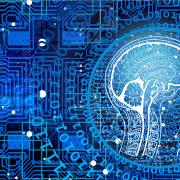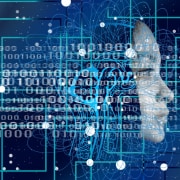|
Getting your Trinity Audio player ready...
|
For many people, the mention of artificial intelligence (AI) and machine learning (ML) starts alarm bells ringing in their heads. Robots taking over humans’ jobs, wanton invasion of privacy, smart machines controlling the world – these scenarios are frightening and all too real to those who fear AI. And in a distant future, who knows, they may happen.
However, we already benefit from AI every day, in our devices and cars (not just the self-driving ones), in robotics and food technology, in healthcare, in the production plants manufacturing items that improve our lives, in Apple’s Siri, Samsung’s Bixby, and Amazon’s Alexa, in retail companies which use AI to improve customer relations or ‘man’ automated check-outs, and even in the kitchen.
There are many helpful ways in which AI and ML can be put to use. Fighting corruption is one of them.
Let’s make this clear first – there are risks associated with using AI in anti-corruption. Transnational crime-focused organisation ENACT outlined some of them in an article published in July this year. The article also presented some compelling beneficial uses, such as the street camera system in Johannesburg that connects to the police database of stolen or suspicious vehicles.
AI brings new potential to put transparency in action, write Nils Köbis, Christopher Starke, and Iyad Rahwan in their 2021 research paper, Artificial Intelligence as an Anti-Corruption Tool (AI-ACT) — Potentials and Pitfalls for Top-down and Bottom-up Approaches.
The authors caution that the success of AI-ACT strongly depends on the implementation approach – top-down (by governments) or bottom-up (by citizens, non-governmental organisations, or journalists). “Top-down use of AI-ACT can consolidate power structures and thereby pose new corruption risks. Bottom-up use of AI-ACT has the potential to provide unprecedented means for the citizenry to keep their government and bureaucratic officials in check.”
So while the learning and problem-solving capabilities of AI offer much potential in the anti-corruption space, there are still issues to be worked out.
“AI-ACT remains to be explored in depth, starting from its conceptualisation, main functionalities, and ethical considerations based on empirical evidence,” writes Fernanda Odilla in a 2023 paper titled Bots against corruption: Exploring the benefits and limitations of AI‑based anti‑corruption technology.
“More research on both the impacts and the new measurements for calculating outcomes is needed. How AI-ACTs should be held accountable, who controls and oversees them, and what types of structures of power and bias they are subjected to are questions that are also worth addressing,” Odilla says. “If we want better anti-corruption efforts, we need to understand how these tools operate, their impacts and risks, who created them, and who is monitoring the monitors. Otherwise, we risk perpetuating the ills we seek to cure.”
Pitfalls and advantages
Clearly there is a good deal of literature available in the use of AI to fight corruption. In terms of research into the specific pitfalls associated with such use, and their effects, not so much.
Some applications of AI and automated decision systems in society remain controversial, writes Per Aarvik, an independent writer on applied digital technology for humanitarianism, development, governance, and anti-corruption, in a 2019 research paper for U4. “Questions persist on how to handle biased algorithms, our ability to contest automated decisions, and accountability when machines make the decisions … Nevertheless, due to the efficiency, apparent neutrality, stable performance, and cost savings associated with AI-based processes, such tools are likely to be applied in more and more areas in the future.”
Privacy concerns, surveillance issues, and possibly opaque decision-making processes are ethical challenges involved in the development of AI-driven systems, Aarvik adds.
But to understand how such development might unfold in the context of anti-corruption, it is important to understand corruption itself. Just like the umbrella concept of AI, the term encompasses various aspects and dimensions and, write Köbis et al, “tackling embezzlement within the political sector differs profoundly from changing bribery schemes in the police force”. Care must be taken, therefore, to specify the type of corruption under scrutiny before developing measures to tackle it.
AI also needs data to work. With more data available than ever before, on any type of corruption imaginable, this is a good sign that AI’s ability to figure out solutions for itself will enhance “the increasingly data-driven efforts to fight corruption”, write the authors.
However, such technologies are only as good as the data they are based on, write Isabelle Adams and Mihály Fazekas in a 2018 paper on emerging technologies. “They may replicate past biases and miss new developments. Criminal groups can also use AI tools to increase their own efficiency and better predict threats to their organisations and business models.”
Similarly, Adams and Fasekas add, while the application of AI technologies carries great promise, the current state of development and lack of scientific evidence means it is difficult to assess the impact of AI on corruption, especially for developing countries.
“Future growth should be accompanied by rigorous assessment and build on existing evidence from other areas of application.”
Advantage of ease and speed
The ability of AI applications to work with datasets too large for manual handling make it possible to reveal or even predict corruption or fraud that previously was nearly or completely impossible to detect, writes Aarvik.
Furthermore, AI-assisted procedures can replace processes known to be prone to corruption or bribery, and using AI to simplify procedures or reduce points of human interaction may promote integrity by narrowing the scope for bribery.
Aarvik cites the example of Kenya, whose government, working with the IBM research group in the country, managed a rankings leap from 136 to 56 out of 189 countries on the World Bank index for Ease of Doing Business, over a relatively short period of years. “They identified complex regulations, inefficiency, and bureaucrats feeling helpless towards the system as the primary drivers for bribes, usually just to speed up the decision processes. The IBM team worked not only on the technical side of the problem, but also addressed the challenge from multiple angles.”
However, Aarvik cautions, digitisation is a prerequisite for AI to be deployed in anti-corruption efforts – and to date, not many countries in Africa have the level of digitisation in society to take advantage of AI.
Furthermore, the mere disclosure of data is not enough to curb corruption, argue Köbis et al. “Someone, whether these are prosecutors, journalists, or civil society actors, needs to be able to draw inferences from data to render it actionable for policy efforts.”
This means that “autonomous agents” must build on that transparency and put its ramifications into action. Transparency in action is something that AI could augment enormously.
“It saves human resources by taking over key tasks of (pre-)screening large datasets, analysing it to enable detecting, predicting and reporting risks, suspicions, or clear-cut cases of crimes like corruption.”
The size of many datasets makes it hard for humans to analyse them at speed – but AI has no such limitations. “Its autonomous abilities allow AI technologies to act based on the insights gained, without requiring further engagement of human actors, like automatically disclosing suspicious cases of corruption. In short, AI can make autonomous decisions about corruption (risks) based on Big Data.”
Support in SA
Various AI applications in pilot phases around the world are providing new insight.
In the UK, a 2018 collaboration between software company Exiger and Transparency International UK has helped the corruption-fighting organisation to automate open-web and database research on its potential partners and third parties, thereby homing in on risks and providing assurance that partnerships are free from corruption.
Transparency International in Ukraine developed the Dozorro tool to monitor the open source government procurement system Prozorro and expose fraudulent bids in public procurement.
South Africa is one of several countries showing support for the concept of AI-ACT – the South African Revenue Service (Sars), as an example, has been talking since 2018 about using AI in its work.
In its 2018/19 annual performance plan (APP), Sars says: “We will expand the use of data and/or data analytics and artificial intelligence to improve the integrity of our records, risk management and to derive critical insights and improve outcomes.”
In its 2022/2023 APP Sars notes its intention to use AI to detect non-compliance in tax returns and payments. It would also “expand and improve the use of data, data analytics and artificial intelligence capabilities to enable Sars to detect non-compliance and illicit economic activities that previously went undetected and enforce accordingly”.
The organisation recognises that its human capacity must “evolve to complement the increasing levels of automated processing and artificial intelligence enabled by data, super computers, and real-time connectivity.”
Its view is backed by that of President Cyril Ramaphosa, who said as recently as 2020: “We need to build on the ‘open tender’ processes employed in certain areas and make use of technology and artificial intelligence as a standard practice to tackle corruption across all of government.”
Academics are also in favour of using AI to fight corruption.
“We can use AI systems to analyse data from multiple sources and identify irregular activity associated with third parties, employees, and customers,” writes Prof Tshilidzi Marwala, the vice-chancellor and principal of the University of Johannesburg. “AI is proficient in wading through emails, text messages, and audio files … It also can predict future risks and identify fault lines.”
With a seemingly endless list of procurement scandals to mull over, citizens are demanding greater transparency around the process for awarding government contracts, says Marwala. “The time has come to harness the latent power of AI and put it to use to ensure ethical behaviour and integrity in practices that lend themselves to greed and inherently corrupt behaviour.”
AI has the potential to be the custodian of social justice, Marwala concludes. “We have the ability and opportunity in this country to use these capabilities to uncover corrupt practices. It is unclear why we do not put it to good use.”






